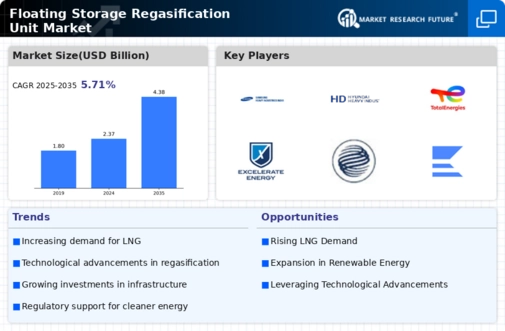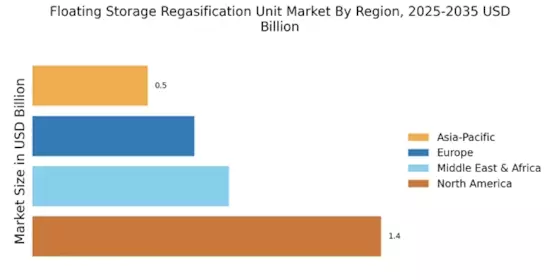Increasing Demand for LNG
The rising demand for liquefied natural gas (LNG) is a primary driver for the Floating Storage Regasification Unit Market. As countries seek to diversify their energy sources and reduce reliance on coal and oil, LNG has emerged as a cleaner alternative. The International Energy Agency projects that global LNG demand could reach 600 million tons by 2030, indicating a robust growth trajectory. This shift towards LNG is likely to enhance the need for floating storage regasification units, which facilitate the efficient conversion of LNG back into gas for consumption. Consequently, the Floating Storage Regasification Unit Market is poised to benefit from this increasing demand, as these units provide a flexible and cost-effective solution for countries looking to import LNG.
Environmental Regulations and Policies
Stringent environmental regulations and policies are increasingly influencing the Floating Storage Regasification Unit Market. Governments worldwide are implementing measures to reduce greenhouse gas emissions and promote cleaner energy sources. The Paris Agreement has set ambitious targets for reducing carbon footprints, which has led to a surge in interest in LNG as a transitional fuel. As a result, the Floating Storage Regasification Unit Market is likely to experience growth as these units enable countries to import LNG more efficiently. The International Maritime Organization's regulations on sulfur emissions are also pushing for cleaner fuels, further driving the demand for floating storage regasification units that facilitate LNG imports.
Strategic Partnerships and Collaborations
Strategic partnerships and collaborations among key stakeholders are playing a crucial role in shaping the Floating Storage Regasification Unit Market. Companies are increasingly forming alliances to share resources, technology, and expertise, which can lead to more efficient project execution and reduced costs. For instance, partnerships between energy companies and engineering firms can enhance the design and construction of floating storage regasification units. Additionally, collaborations with governments can facilitate regulatory approvals and streamline the deployment process. This trend of strategic alliances is likely to foster innovation and accelerate the growth of the Floating Storage Regasification Unit Market, as stakeholders work together to meet the rising demand for LNG.
Technological Innovations in Regasification
Technological innovations in regasification processes are enhancing the efficiency and appeal of the Floating Storage Regasification Unit Market. Advances in cryogenic technology and heat exchange systems are improving the performance of floating storage regasification units, making them more efficient and cost-effective. These innovations are likely to reduce operational costs and increase the reliability of LNG supply chains. Furthermore, the integration of digital technologies, such as IoT and AI, is enabling better monitoring and management of regasification processes. As these technologies continue to evolve, they are expected to drive the growth of the Floating Storage Regasification Unit Market by attracting more investments and facilitating the deployment of advanced units.
Infrastructure Development in Emerging Economies
Emerging economies are witnessing significant infrastructure development, which is likely to bolster the Floating Storage Regasification Unit Market. Countries in Asia and Africa are investing heavily in energy infrastructure to support their growing populations and industrial sectors. For instance, nations like India and Nigeria are expanding their LNG import capabilities, which necessitates the deployment of floating storage regasification units. The World Bank has indicated that investments in energy infrastructure in these regions could exceed 1 trillion dollars by 2030. This influx of capital is expected to create a favorable environment for the Floating Storage Regasification Unit Market, as these units offer a viable solution for meeting the energy demands of rapidly developing economies.


















Leave a Comment